Views: 0 Author: Site Editor Publish Time: 2024-03-06 Origin: Site








Scaffolding is a temporary work platform built to ensure the smooth operation of various projects. It enables construction workers to work safely and efficiently at various heights. Scaffolding is typically used in construction, maintenance, bridges, shipbuilding, high-altitude tasks, or in places that are hard to reach.
The use of scaffolding can be traced back to Ancient Greece and Egypt in the 5th century BC. Evidence suggests that wooden scaffolding was in use during this time. However, the first steps towards modern scaffolding began in Ancient China, where bamboo was tied together with ropes, creating structures similar to what we still see today. It wasn't until the 20th century, with the widespread use of steel pipes (lighter than wood), that scaffolding began to truly take shape and become the safe, modular scaffolding we use today. After World War II, in order to implement construction projects moresafely, various new regulations were established to ensure worker safety. These advancements prompted the introduction of new materials, making the assembly, use, and disassembly of scaffold towers easier and safer. Aluminum and lighter steel replaced the old steel pipes, and composite materials are sometimes used in areas where greater strength is needed.
Scaffolding is an essential part of most construction projects. Workers choose different scaffolding based on the specific requirements of their projects, each with its unique qualities and advantages. The following list provides detailed information about the different types of scaffolding you might find on a construction site:
The system scaffold, also known as a modular scaffold, primarily consists of horizontal and vertical components, and its stability is enhanced with diagonal braces. Here are several types of system scaffolding:
The ringlock system scaffolding is a type of scaffold, where the rosettes on the vertical poles and the ledger heads of the horizontals are connected by wedges. The space between the rosettes on the vertical poles is every 500mm. This system is widely used around the world.
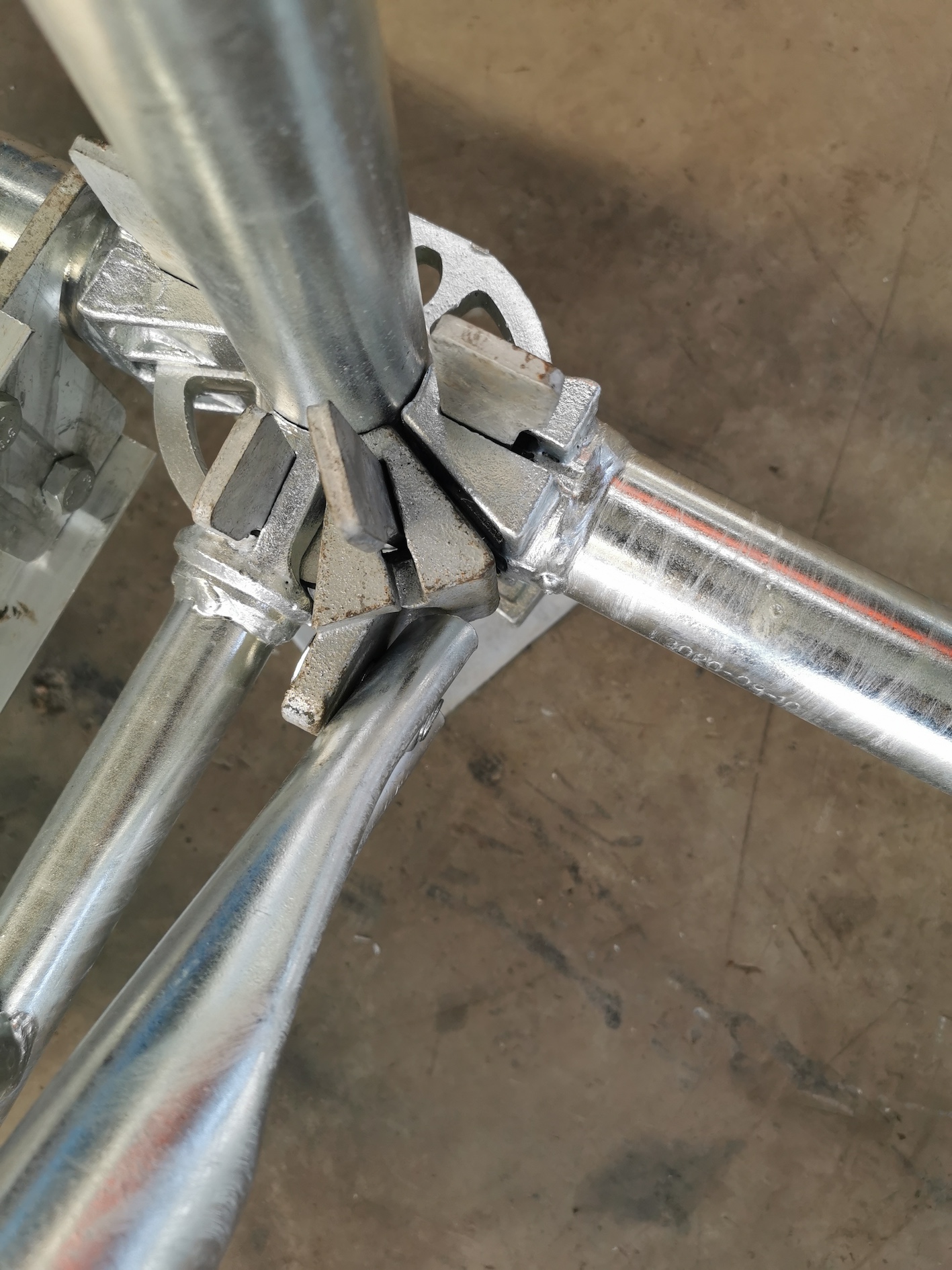
The cuplock system scaffolding is a type of scaffold, where cups on vertical poles are connected to horizontals by blades. The space between the cups is every 500mm.

The Kwikstage System scaffolding is connected by V-locks and horizontal wedges, with a spacing of 500mm between the V-locks of the vertical poles. This system is mainly used in the UK, Australia, and New Zealand. A modified version is also used in South Africa.
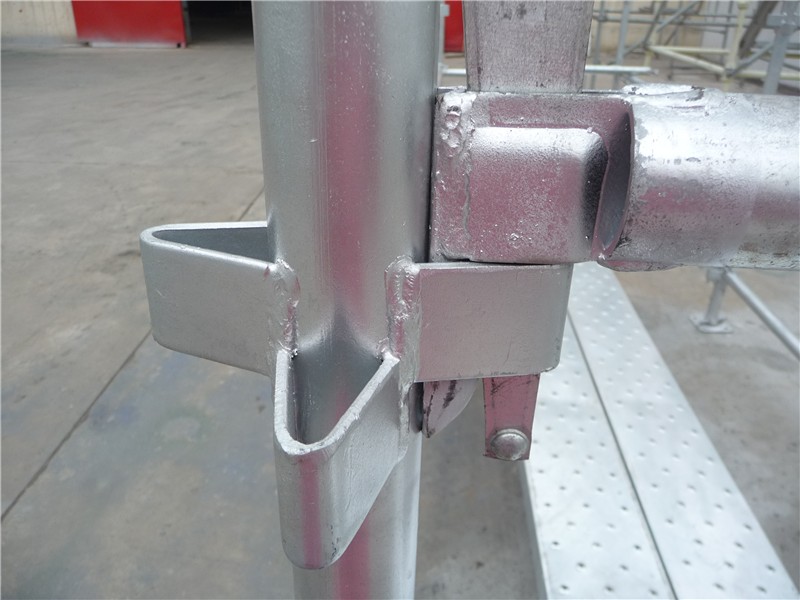
Haki Scaffolding
The Haki scaffolding system uses a unique hook on pattern, and fewer components make it lighter. It is widely used in Europe.

Tube and coupler scaffolding is a type of structure made from steel pipes and various couplers. The standard outer diameter of the steel pipes is 48.3mm, and they come in various lengths. Couplers mainly include right-angle couplers, swivel couplers, putlog couplers, sleeve couplers, girder couplers, etc..
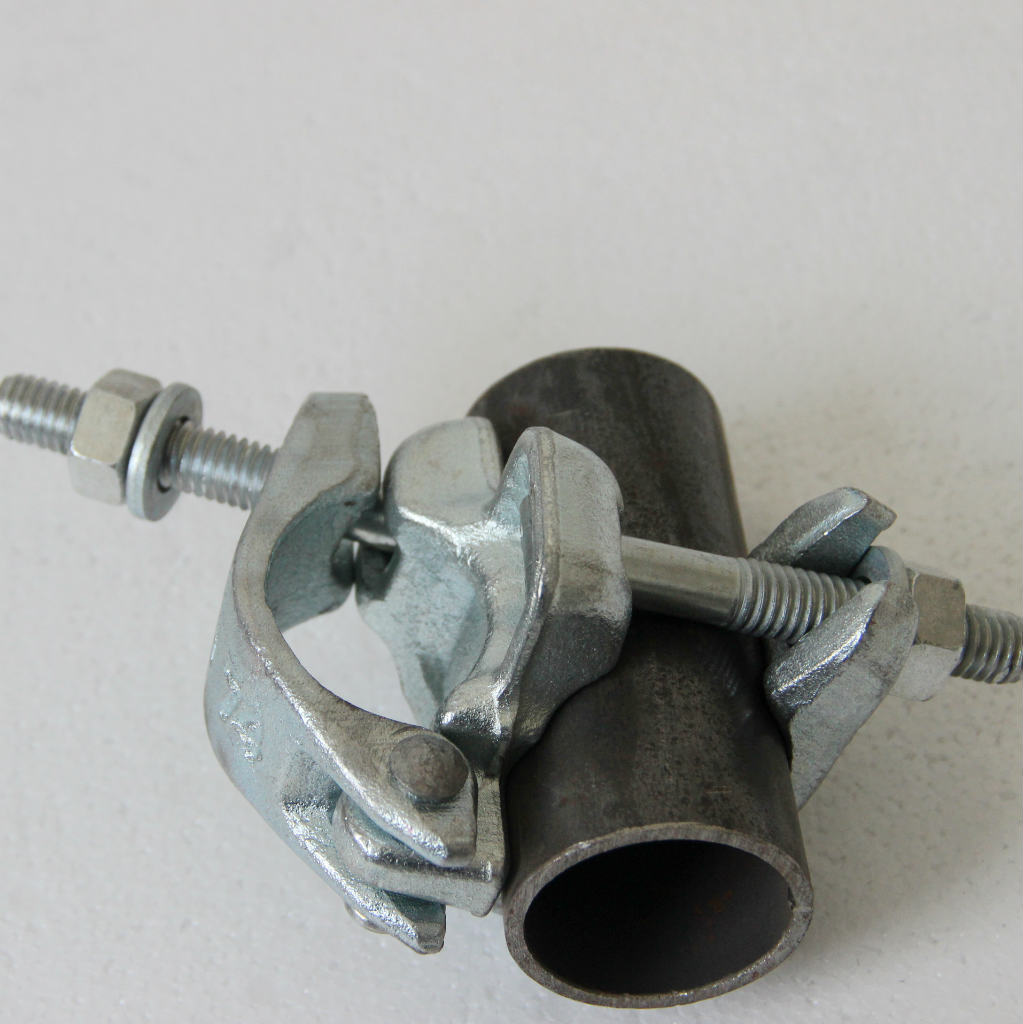
The frame and brace scaffolding, commonly used in North America, consists of frames, braces, walk boards, and screw jacks. Its strength is not as high as that of system scaffolding.
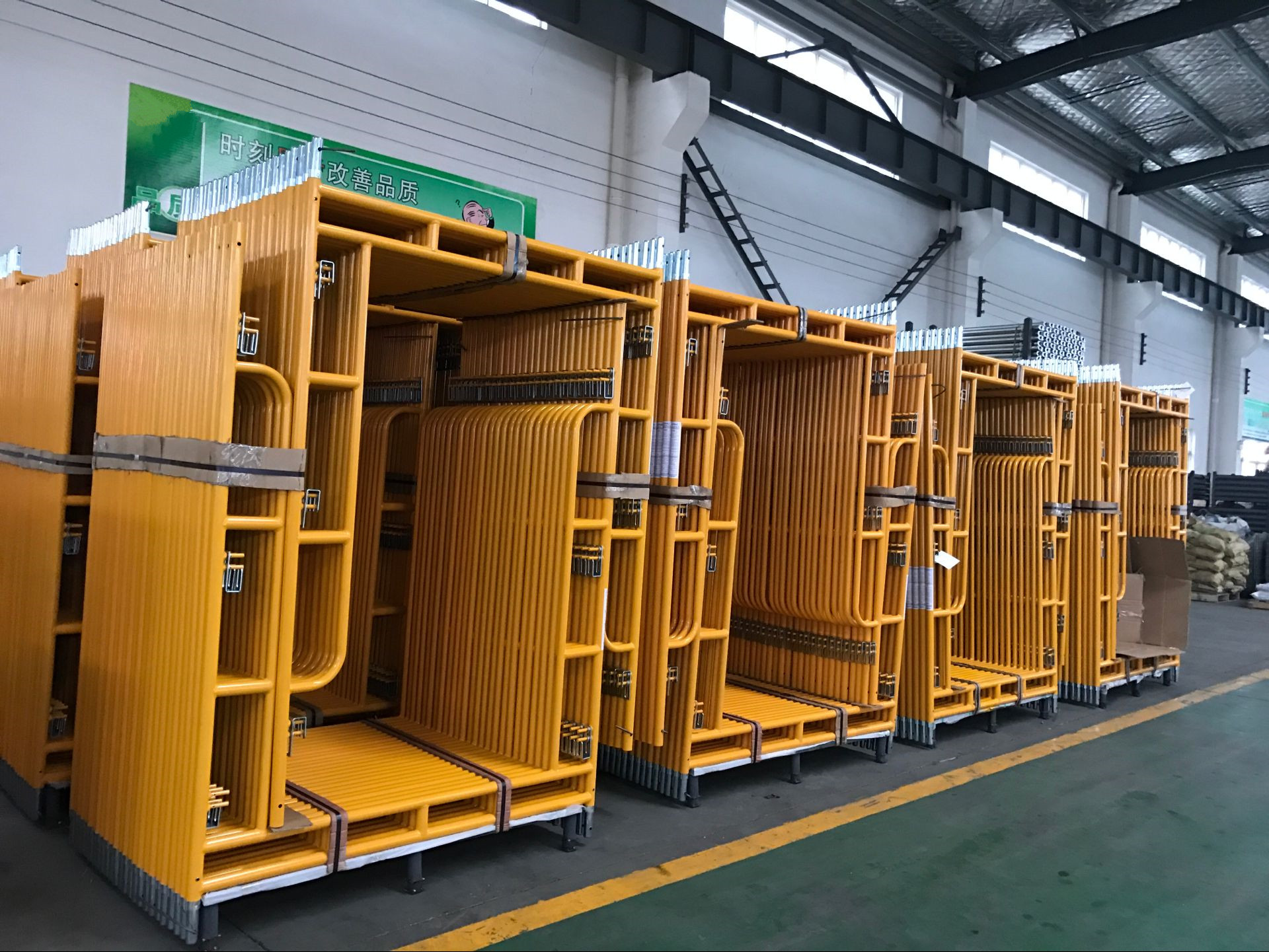
Mobile scaffolding, with installed casters, is commonly used for tasks such as painting or plastering, making it easy for workers to move around. It mainly includes aluminum mobile scaffolds, Baker scaffolds, or mini scaffolds.
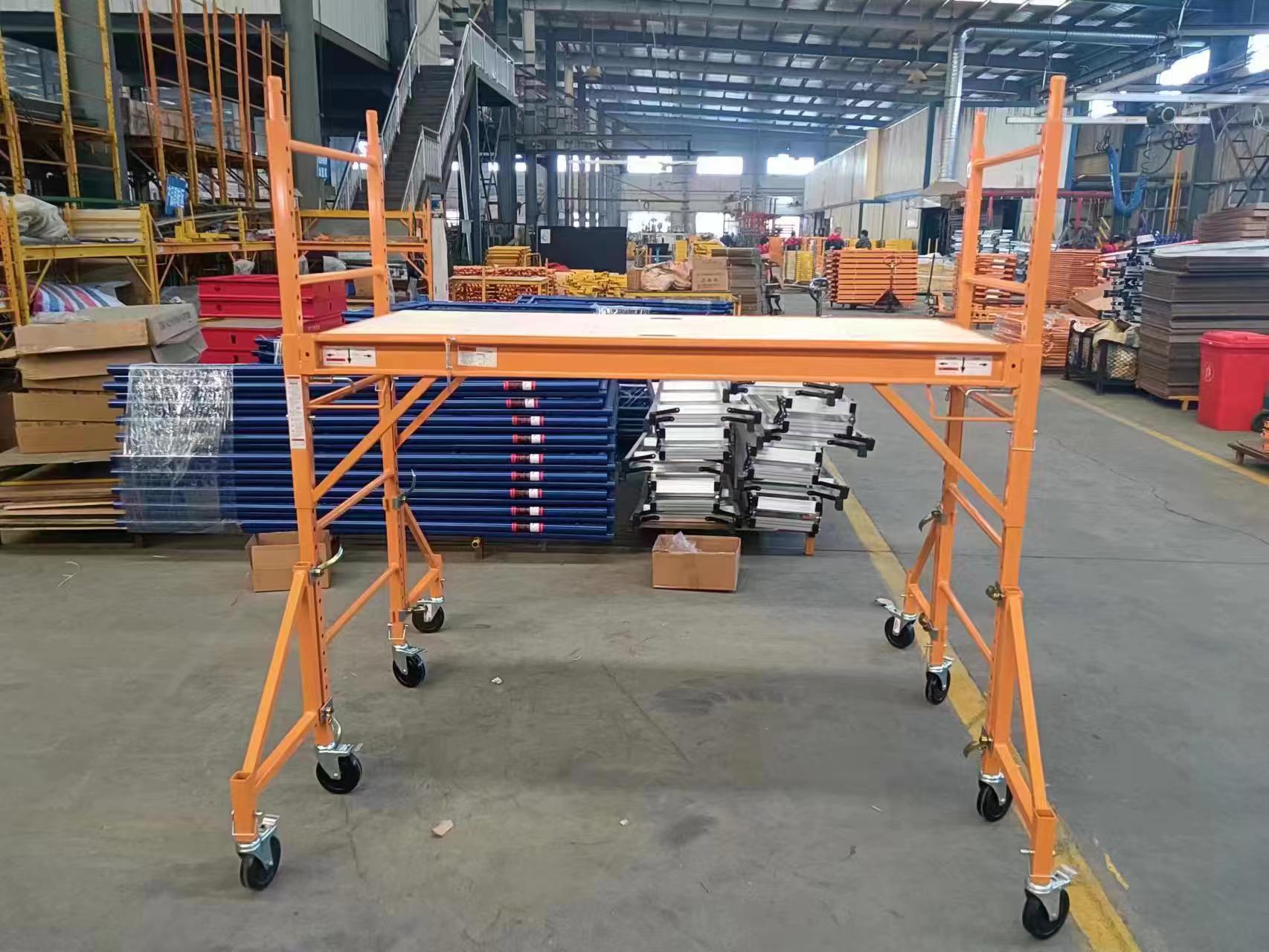
Shoring scaffolding is primarily used for supporting formwork concrete, mainly composed of shoring frames and steel props.
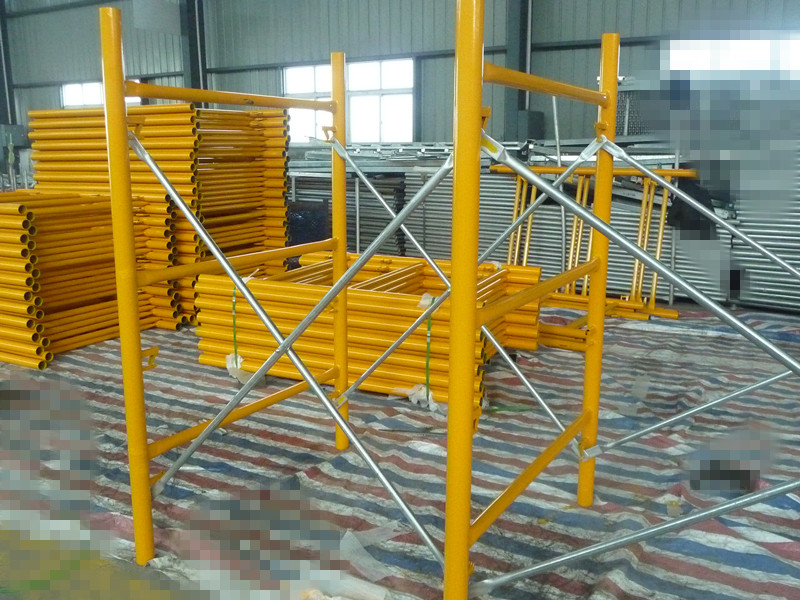
A suspended scaffold is a platform that hangs from overhead structures using ropes or other non-rigid devices.
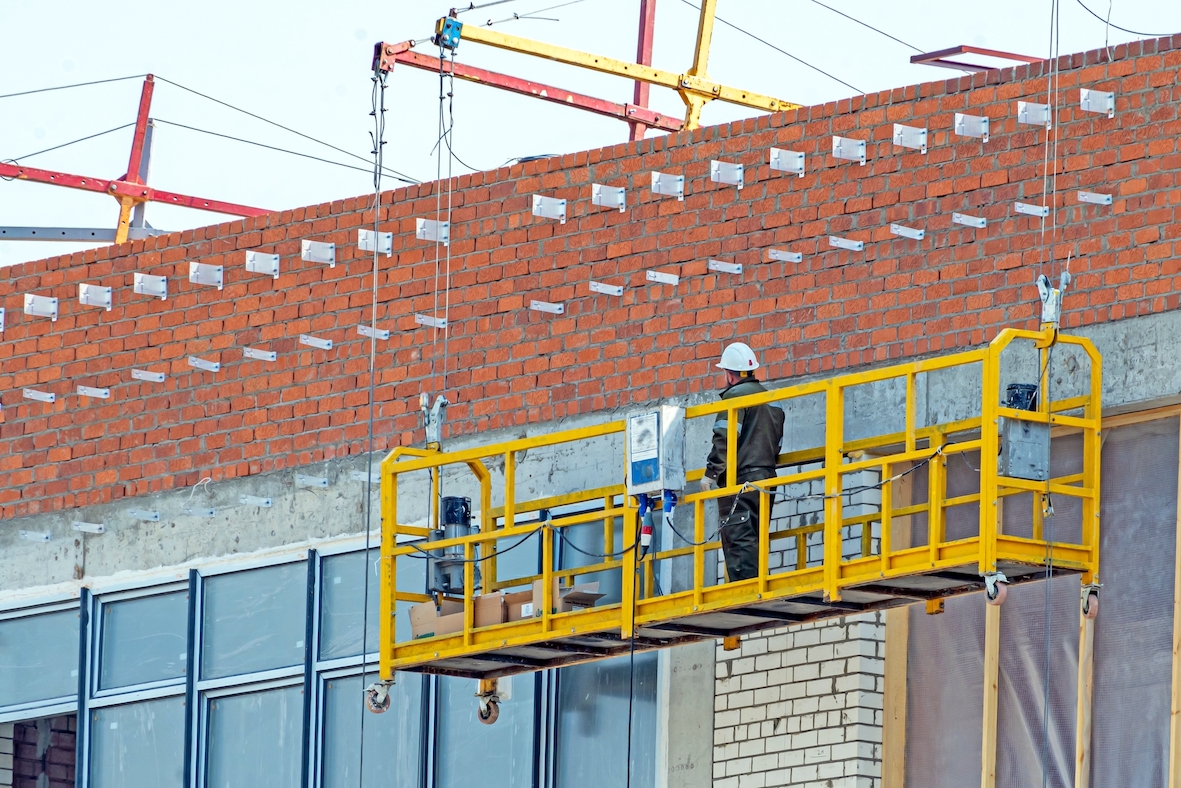
The cantilever scaffold, also known as a needle-type scaffold, is an independent scaffold that leans out from the structure. This type of scaffold is typically located near a balcony, for easy access.

A Trestle Scaffold, typically composed of a trestle, braces, and attachments, is commonly used for renovation and similar tasks.
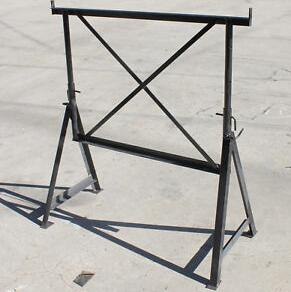
The Facade scaffolding is designed for facade projects (painting, repairs, insulation) or roofing.

Fiberglass scaffolding is light, non-conductive, and resistant to chemical corrosion. It's suitable for tasks in specific situations.

Wooden & bamboo scaffolding, a traditional type of scaffolding, is still in use in some regions.
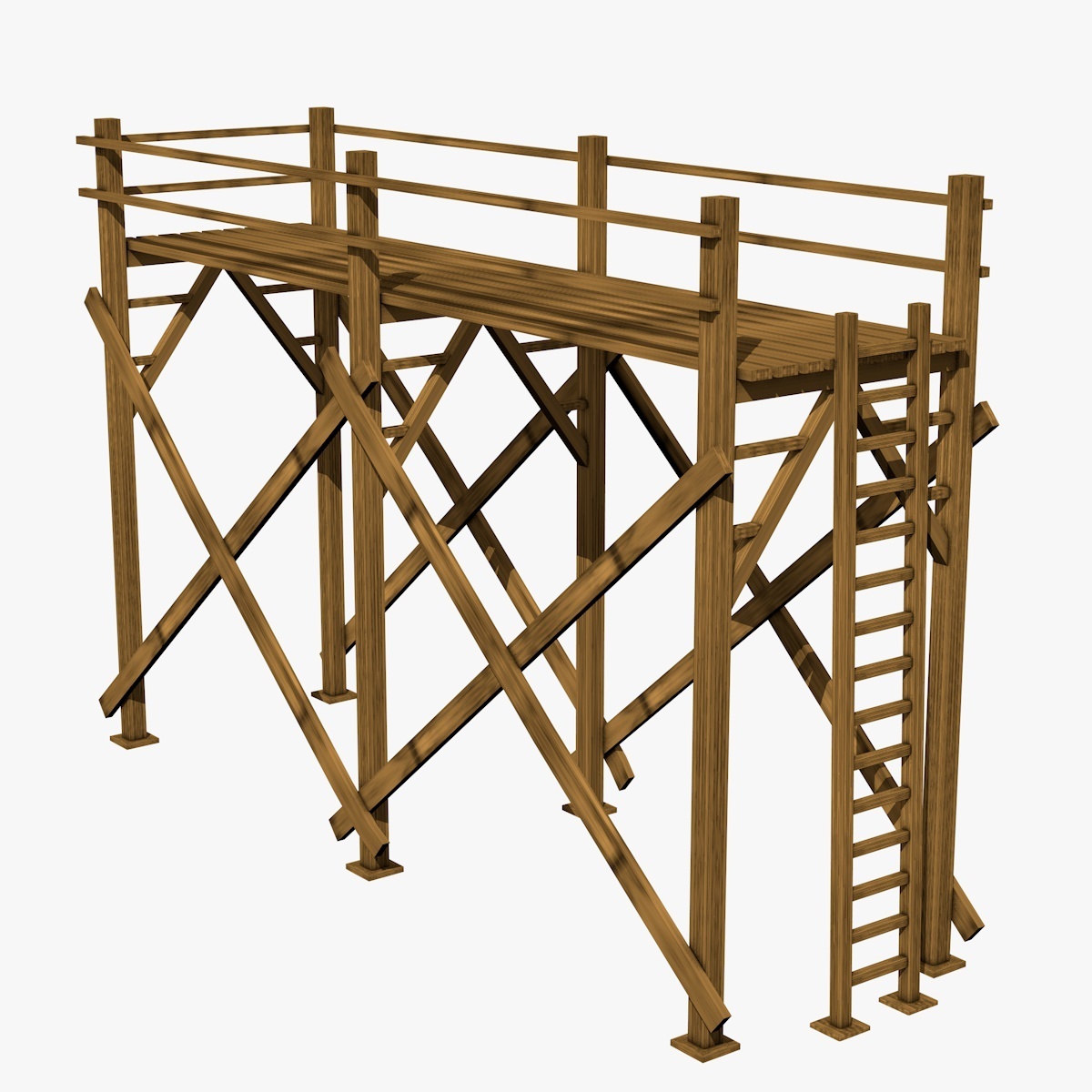
The main parts of the scaffolding include the vertical poles, horizontals, diagonal braces, walk boards, base plates, screw jack, side brackets,couplers, lock pins, and so on. These parts are essential for the structure and function of the scaffolding.
Scaffolding materials can be categorized as wood, aluminum, steel, and fiberglass.
After the 1920s, wooden scaffolding was gradually replaced by aluminum and steel. Modern usage of wooden scaffolding is limited mainly to walk boards, which are light, easy to install, and low-cost in timber-rich areas. But it's less commonly used due to low strength, susceptibility to decay, high maintenance cost, risk of pests, and tendency to break.
Aluminum scaffolding is durable, lightweight, and easy to assemble, disassemble, and transport. Although it's more expensive, it's preferred in areas where labor is costly.
Steel is most frequently used in modern scaffolding for its high strength and lower cost compared to aluminum, even though it's three times heavier, allowing for high load-bearing and flexibility. However, it's more prone to corrosion and its weight presents challenges in installation and transportation.
Fiberglass, a type of fiber-reinforced plastic, is a newer and less-known material in scaffolding. Despite its high cost, it's chosen for projects at risk of electrical shock due to its corrosion resistance and non-conductivity.
In conclusion, there's no definitive 'best' scaffolding material. The choice should be made based on the specific project and environmental conditions.
The scaffolding allows workers to access some hard-to-reach or dangerous buildings.
The ideal balance ensures that workers do not have to worry about instability and safety issues during construction.
Strict regulations, good designs, sturdy installations, and standardized operations ensure the safety of both workers and projects.
Thanks to easy access and safety guarantees, workers have greatly improved their productivity.
The development of modern scaffolds has made assembly and disassembly very convenient.
Scaffolds provide numerous bridging points to reduce the distance workers need to walk, saving time and energy, and making projects easier.
Whether it's steel or aluminum scaffolds, both offer durable advantages.
The scaffoldings are not only of good quality but can also be reused in compliant circumstances, making them an economic and efficient choice.
To rent or buy scaffolding? If your project is short-term, or if your budget is limited, then renting scaffolding is a good choice, and you don't have to worry about storing and maintaining the scaffolding. If you wish to use scaffolding for a longer period, or if you're considering investing in scaffolding, and are not concerned about the availability of scaffolding or rental company's date restrictions, then purchasing scaffolding could be the way to go."
The scaffold needs to be inspected regularly by authorized individuals who have undergone training. They need to ensure the safety of the construction site, verify that the correct type of scaffold is being used, ensure safe load-bearing, and consider weather conditions. Subsequently, they must check if the ground is firm and even, ensure every component of the scaffold is installed correctly, and assert that horizontals are not used as ladders. They also need to inspect if there are any defects in the ropes. After all the checks are completed, corresponding tags need to be hung for reminder or warning purposes.
First, we need to buy quality raw materials from a professional factory. After receiving them, we check the thickness, length, and material grade again. If they pass, we proceed to cutting, punching, bending, or shaping. Then, welders weld them in pretested fixtures, ensuring no air gaps or missed spots. Welded parts are initially assembled to check dimensions, then they are polished to remove burrs before surface treatment. After surface treatment, some reshaping or surface repairs may be needed, then another assembly check is needed. Once everything is correct, the scaffolding will be well packed.
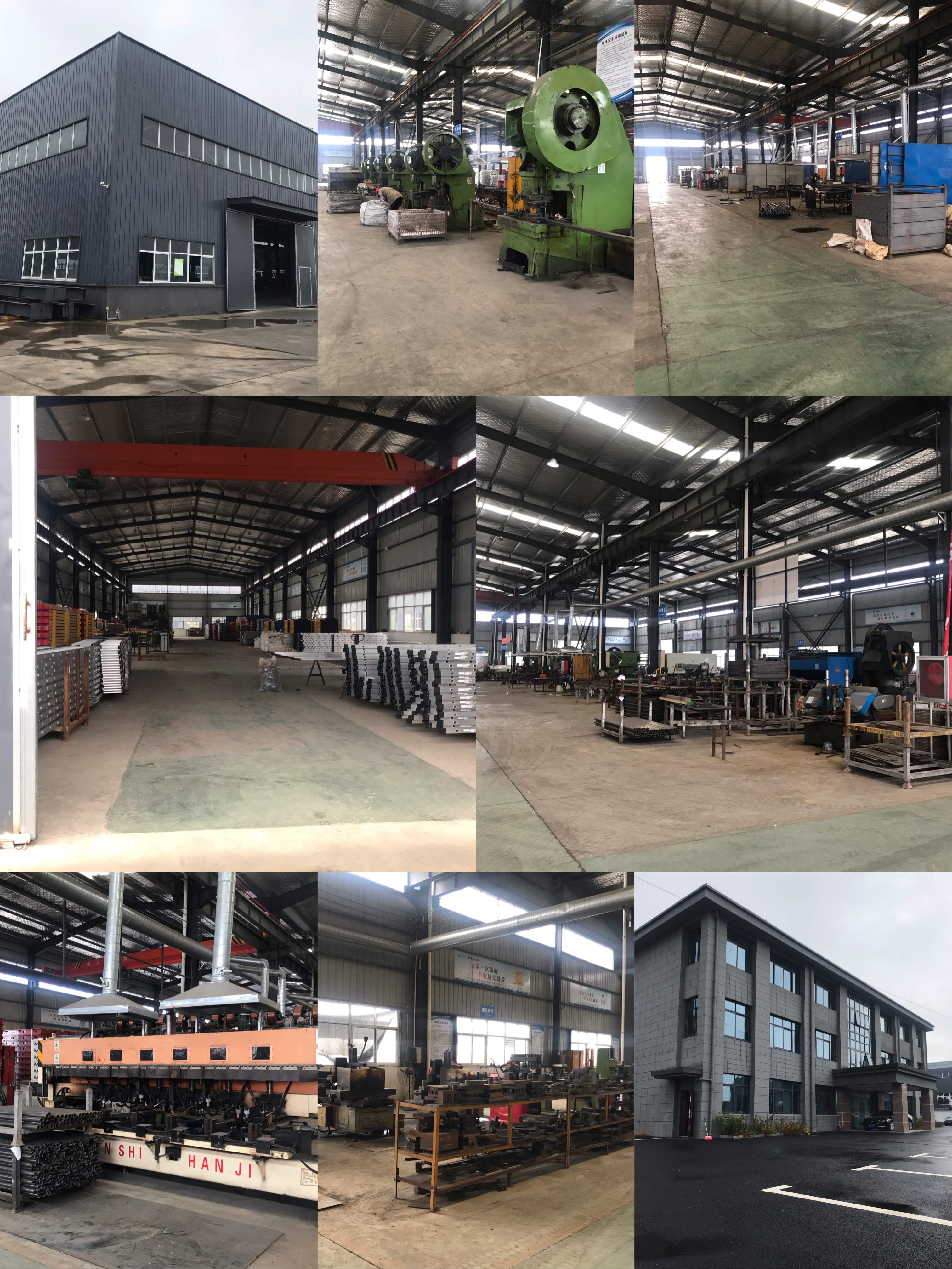
(Nanjing Tuopeng Workshop View)
Scaffolding pipes generally need to comply with the EN39 standard, made of hot-dip galvanized steel or aluminum tubes with an outer diameter of 48.3mm and a wall thickness of 3.2mm-4mm.
The maximum height at which a ladder jack scaffold should be placed is 20ft.
Scaffolding is divided into three different loading capacity categories: light-duty, medium-duty, and heavy-duty. Light-duty scaffolding can support 25 LBS per square foot, medium-duty scaffolding can support 50 LBS per square foot, and heavy-duty scaffolding can support 75 LBS per square foot.
Painted scaffolding is relatively cheaper, while hot-dip galvanized scaffolding is more expensive but more durable and requires less maintenance.
Firstly, it is important to regularly inspect scaffolding, especially during cold winter months. If it snows and freezes, remove the snow and ice. For personal protection, scaffold workers should wear warm, high-visibility clothing and use protective gear. Workers should be provided with slip-resistant shoes to reduce the risk of slipping on wet surfaces.
Scaffolding is often used at heights or hard-to-reach areas, so ensuring safety is crucial. Risk assessment not only reduces the chances of accidents but also shows that the company is taking adequate measures to ensure safety and comply with the law to protect people involved in construction work.
The scaffolding supplier you choose must meet relevant safety standards for product quality. If they are a rental supplier, make sure they regularly maintain their products.
Select a company with a wide range of products for better purchasing efficiency.
Competitive pricing is important for your budget and profit.
Timely delivery affects your sales, rentals, or project plans.
Good after-sales support is crucial.
Consider the supplier's industry expertise, experience, positive customer feedback, and sales team communication skills.
Nanjing Tuopeng Construction Technology Co., Ltd. specializes in providing a wide range of scaffolding solutions, including system scaffolding, tube and coupler scaffolding, frame and brace scaffolding, shoring and props, as well as various steel and aluminum products. Whether you have a large-scale project or a smaller task at hand, we are here to help. Get in touch with us today at info@tp-scaffold.com or call us at +86 187 6181 1774. We look forward to assisting you!
Scaffolding not only needs to be safe and reliable but also cost-effective and easy to install and dismantle. Due to the diversity of construction projects and environments, as well as the varying safety regulations in each country, scaffolding is divided into many different types. Below is a detailed introduction to them.
Scaffolding is a building structure that consists of many different components. The parts of scaffolding vary widely depending on the type of construction, project requirements and site conditions. There are also differences between different types of scaffolding. In addition, different countries have different scaffolding choices. However, scaffolding still includes some basic components that make up the basic structure of any scaffolding, although the way they are designed and how these elements fit together may vary. Let's take a closer look at these basic components.
Scaffolding- The Ultimate Guide for Beginners and ExpertsWhat is Scaffolding?Scaffolding is a temporary work platform built to ensure the smooth operation of various projects. It enables construction workers to work safely and efficiently at various heights. Scaffolding is typically used in construc
This website displays various ranges of scaffolding materials and metal products that we deal with. There will be continuous updates about scaffolding production, shipment, and industry news.
5' Wide x 6' 6" Tall Walk-Thru Scaffold Frame Set Frame Leg: 1.625" OD (1-5/8") Lock Spacing is 27-3/4" Each Set Includes: 2 - 5'W x 6' 6"T Walk-Thru Scaffold Frames 2 - 7' x 27-3/4"' Tubular Cross Braces 4 - Coupling Pins (1-3/8") 4 - Spring Clips This Frame has 3-Locks on each Leg (27-3/4" between Locks).
The layher scaffolding is a new type of in-line steel scaffold with self-locking function. This article will introduce the relevant knowledge of the layher scaffolding, and I hope it will be helpful to everyone. Features of layher scaffolding.The company owns layher scaffolding products.
Scaffolding provides numerous advantages in construction projects, ensuring safety and efficiency. Let’s take a detailed look at the benefits that scaffolding brings to us.
IntroductionIn the dynamic world of construction, the choice of scaffolding material is crucial. It impacts not only the efficiency and safety of a project but also its overall cost. This guide delves into the pros and cons of various scaffolding materials, helping you make an informed decision tail
One of the most important parts of the falsework is the foot pedal clutch, so you need to choose a foot pedal clutch with sufficient capacity. Before purchasing a scaffolding connector, it must be thoroughly tested and verified. If you need durable, reliable and cheap scaffolding connectors, Nanjing Tuopeng Construction Technology Co., Ltd. can provide ideal products.
Construction scaffolding is the basis of a renovation, especially in this period, with the 110% bonus and the facade bonus, the demand for construction scaffolding has skyrocketed and so has the respective price. Let's analyze in detail everything related to scaffolding focusing on